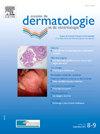甲膜内注射曲安奈德治疗甲扁平苔藓的疗效和安全性:回顾性数据分析
IF 3.1
4区 医学
Q2 DERMATOLOGY
引用次数: 0
摘要
背景:10-15%的扁平苔藓患者会发生指甲扁平苔藓(NLP),其特征是不适和永久性损伤的可能性。局部曲安奈德(TA)是一线治疗;然而,缺乏全面的疗效数据。目的采用甲基质内注射(5 mg/ml),每隔4周和8周对患指甲和脚趾甲进行平甲苔严重程度指数(NALSI)评价和比较平甲苔严重程度的变化。方法回顾性分析17例NLP患者在11 年以上接受基质内TA(5 mg/ml)治疗的资料。对每次就诊的照片记录进行分析,使用NALSI评分疾病严重程度。比较第三次和第六次注射时指甲和脚趾甲达到NALSI-50的百分比(NALSI比基线降低50%)。结果17例患者发生扁平苔藓的指甲232根(68.2%),其中指甲130根(56%),趾甲102根(44%)。的平均基线NALSI 7.4±2.7 指甲,下降到6.6 ±2.7 第三会话,和4.2 ±3.2 6会话,而对于脚趾甲从7.02下滑 ± 2.6到6.6 ± 2.5和5.9±3.0 ,分别。到治疗终点(分别在第五次注射后4/8周,指甲和脚趾甲),40.7%的指甲和10.8%的脚趾甲的NALSI-50降低;而指甲和脚趾甲的NALSI-75含量分别降低了21.5%和4.9%。在整个治疗干预过程中,指甲出现不可逆改变的比例稳定在11.5%。然而,观察到脚趾甲的显著增加,从基线的11.7%上升到研究结束时的13.7%。不良反应包括疼痛(23.5%),近端甲襞色素沉着和萎缩(23.5%),趾骨下血肿(17.6%)。结论皮下注射TA(5 mg/ml)治疗NLP安全有效,且对指甲有较好的疗效。本文章由计算机程序翻译,如有差异,请以英文原文为准。
Efficacy and safety of intramatricial triamcinolone acetonide injections in nail lichen planus: A retrospective data analysis
Background
Nail lichen planus (NLP) impacts 10–15% of patients with lichen planus and is characterized by discomfort and the potential for permanent damage. Intralesional triamcinolone acetonide (TA) is a first-line treatment; however, comprehensive efficacy data is lacking.
Objective
To evaluate and compare changes in nail lichen planus severity using the Nail Lichen Planus Severity Index (NALSI) in affected fingernails and toenails treated with intramatricial TA (5 mg/ml) injections at 4-weekly and 8-weekly intervals, respectively.
Methods
A retrospective analysis was done for 17 NLP patients treated over 11 years with intramatricial TA (5 mg/ml). Photographic records from each visit were analysed to score disease severity using NALSI. Comparison was made of the percentage of fingernails versus toenails achieving NALSI-50 (50% reduction in NALSI over baseline) at the 3rd and 6th injections.
Results
These 17 patients had 232 nails (68.2%) affected by lichen planus, of which 130 (56%) were fingernails and 102 (44%) were toenails. The mean baseline NALSI of 7.4 ± 2.7 for fingernails, decreased to 6.6 ± 2.7 at the 3rd session, and 4.2 ± 3.2 at 6th session, while for toenails it dropped from 7.02 ± 2.6 to 6.6 ± 2.5 and 5.9 ± 3.0, respectively. By the treatment endpoint (4/8 weeks after fifth injection, respectively, for fingernails and toenails), NALSI-50 reduction was achieved in 40.7% fingernails and 10.8% toenails; while NALSI-75 reduction was achieved in 21.5% fingernails and 4.9% toenails, respectively. Throughout the course of the therapeutic intervention, the proportion of fingernails exhibiting irreversible alterations remained stable at 11.5%. However, a notable increase was observed for toenails, rising from 11.7% at baseline to 13.7% by the conclusion of the study. The adverse effects included pain (23.5% of patients), proximal nail-fold hyperpigmentation and atrophy (23.5%), and subungual hematoma (17.6%).
Conclusion
Intramatricial TA (5 mg/ml) injections are safe and effective in the treatment of NLP, with greater efficacy being noted in fingernails.
求助全文
通过发布文献求助,成功后即可免费获取论文全文。
去求助
来源期刊
CiteScore
1.40
自引率
0.00%
发文量
70
审稿时长
81 days
期刊介绍:
Les Annales de dermatologie sont le rendez-vous mensuel incontournable de toute la dermatologie francophone, grâce à leur comité de rédaction qui assure une sélection rigoureuse des articles selon les normes de l''édition scientifique internationale.
Une revue didactique, véritable aide à la pratique médicale quotidienne
Pour compléter et enrichir la partie scientifique, la rubrique Formation médicale continue propose aux lecteurs des textes didactiques et interactifs (Cas pour diagnostic, Notes de pharmacovigilance, la Question du praticien, Dermatologie chirurgicale, la Sélection bibliographique du mois...) qui les font bénéficier d''une formation post-universitaire diversifiée et de qualité. La revue consacre également un espace pour la publication de questions des lecteurs auxquelles des experts apportent une réponse.

 求助内容:
求助内容: 应助结果提醒方式:
应助结果提醒方式:


